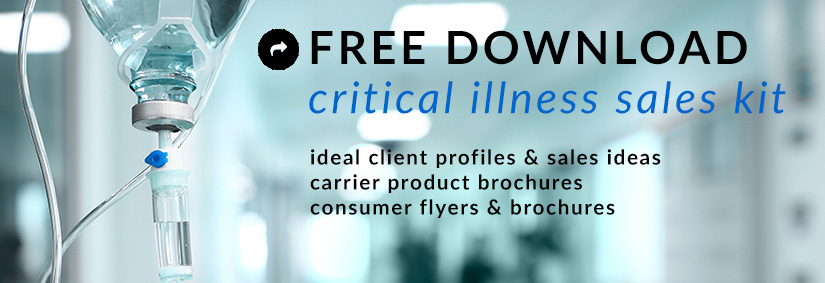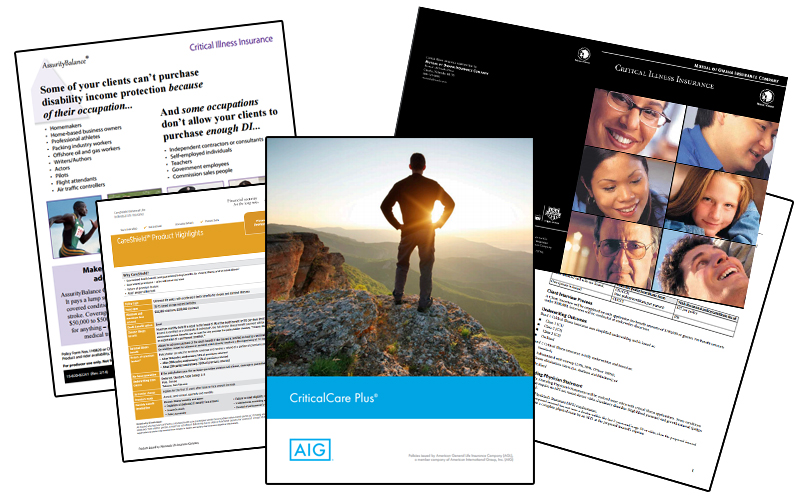
Get the Kit
Our FREE 46-page critical illness insurance sales kit for 2016 includes:
- 3 pages of client profiles & sales ideas
- 12-page AIG consumer brochure
- 4-page Mutual of Omaha consumer brochure
- 23-page Mutual of Omaha field reference guide to critical illness insurance
- 1-page Mutual of Omaha critical illness premium worksheet
- 1-page fact sheet on critical illness insurance
What Does Critical Illness Insurance Do?

The number one reason our clients need critical illness insurance is cash.
Cold, hard cash.
When a serious illness strikes, the cost of medical care is just the beginning.
While health insurance may help cover the cost of diagnosis and treatment, our clients still have co-pays and co-insurance to deal with.
They may need experimental treatments, or non-formulary drugs that cost more than they can afford.
Additionally, there's a good chance they'll miss work to receive treatment. Chances are also good that a family member will miss work to help care for them. However, while disability insurance can help replace part of these lost wages, long elimination periods often mean families have expenses they can't meet in the meantime.
That's where critical illness insurance comes in.
Get the KitUses for Critical Illness Insurance
Critical illness insurance pays cash when your client is diagnosed with a serious illness such as cancer, heart attack, organ failure/transplant, or stroke.
Your client's family can use that cash for anything. Common uses include:
- retrofitting a house for impaired mobility
- seeking alternative treatments or medications not covered by health insurance
- hiring staff for temporary in-home health care
- paying the rent or mortgage
- keeping a business running
- taking a family vacation to bond and regroup during a difficult time
All these uses are about reducing stress - and keeping families together. When something as serious as cancer strikes, the cash from a critical illness payout can even be used to fly faraway family members in for a visit. Expenses like this are hard to anticipate, and even harder to budget.
Get the KitHow to Use This Month’s Sales Kit
You'll probably agree that the number one challenge in selling CI is educating the client about what it can do.
First, browse the field guide in this month's kit to familiarize yourself with CI. Next, use client brochures to reach out to prospects, letting them know this type of insurance exists. Many of them won't be familiar with it. Even if they're not ready to pursue it right away, it's important they know you can help them if and when they do decide to buy. Not sure how to answer all their questions? That's what we're here for. Call our brokerage directors, and we'll answer questions and help you close the sale.
Lower-value policies (under $100,000) are often available without medical underwriting. Check each carrier's list of uninsurable conditions to make sure your client qualifies. Common disqualifying conditions include multiple sclerosis, type 1 diabetes, and coronary artery bypass.
How to Find Clients to Approach
A good starting point is to seek out clients who can't buy disability income insurance because of their occupation - think about homemakers, self-employed business owners, oil and gas workers, and pilots, to start with.
A second good place to look is among clients you know personally, or have connected with on social media. Do they have a family member or close friend who's been diagnosed with cancer? Chances are, they already have a good understanding of the expenses that stockpile when facing a serious illness.
Critical Illness Spotlight: Stroke
50% of all Americans have 1 of 3 major risk factors for stroke.
Strokes cost an estimated $34 billion each year
in health care, medication, and missed work.
Are your clients prepared with critical illness insurance?
Source: Stroke Facts, CDC.gov

